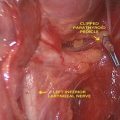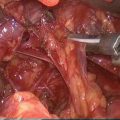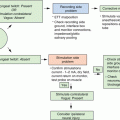Fig. 10.1
Skin incision; thyroid lobe is medially retracted while the strap muscles are retracted laterally, using two little Farabeuf; endoscope (5 mm – 30°) and the dedicated small surgical instruments are introduced through the single skin incision without any trocar utilization; the dissection is carried out by a blunt technique using two dedicated instruments called spatulas
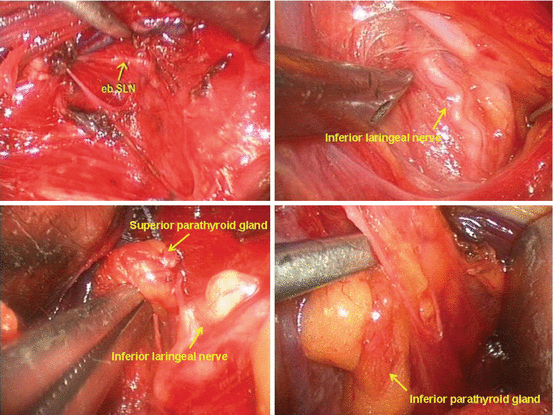
Fig. 10.2
Visualization of external branch of the superior laryngeal nerve, inferior laryngeal nerve and parathyroid glands
After checking the haemostasis, the strap muscles are sutured along the midline as well as the platysma. The skin is closed by means of a not re-absorbable subcuticular running suture or by a skin sealant. Usually, no drainage is left inside (Fig. 10.3).
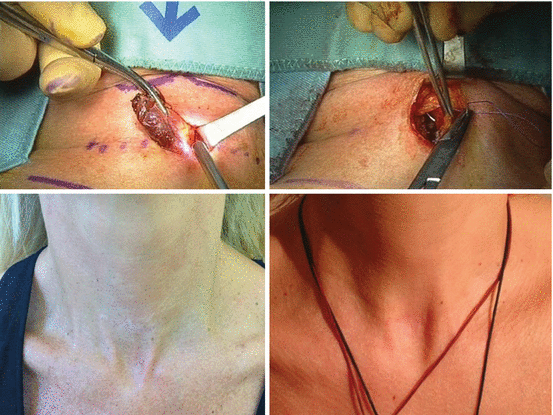

Fig. 10.3
Thyroid lobe extraction; closure; aesthetics results
10.5 Personal Series
We published a review of our experience [53] to evaluate the results obtained in a series of patients selected for MIVAT over a 10-year period. All patients who underwent MIVAT from June 1998 to June 2009 were considered. The eligibility criteria for video-assisted thyroidectomy were thyroid nodules < or = 35 mm; estimated thyroid volume < 30 ml; no previous conventional neck surgery and/or radiation therapy; small, low-risk papillary thyroid carcinoma. A total of 1363 video-assisted thyroidectomies were attempted in the time period considered. Conversion to the conventional procedure was necessary in 7 cases. Thyroid lobectomy was successfully performed in 157 cases, total thyroidectomy in 1175, and completion thyroidectomy in 24. In 126 patients, the central neck nodes were removed through the same access. Simultaneous video-assisted parathyroidectomy, for a parathyroid adenoma, was performed in 42 patients. Pathological studies showed benign disease in 986 cases, papillary thyroid carcinoma in 368 cases, C-cells hyperplasia in 1 case, and medullary microcarcinoma in 1 patient with RET germline mutation. Postoperative complications included 27 transient and 1 definitive recurrent laryngeal nerve palsy, 230 transient hypocalcaemia, 10 definitive hypoparathyroidism, 4 postoperative haematoma, and 5 wound infection.
10.6 MIVAT: Evidence-Based Recommendations
Level of evidence in evidence-based medicine is frequently used for the recommendation of specific treatments [54, 55]. A well-conducted large prospective randomized trial is assigned the highest level of evidence (level of evidence 1) that by definition determines a high grade of recommendation (grade A) [56, 57].
Immediately after the first described case of minimally invasive thyroidectomy, several reports consisting in technical description of the feasibility of different techniques, without any grade of recommendation, were published [4–19].
Moreover, at least two multicentre studies [27, 58] demonstrated the feasibility of the technique. Their results did not reach a high level of evidence because of the retrospective model. Some other large retrospective studies had the same scarce power in terms of evidence [53, 59–63].
Gal et al. [23] and El Labban [24] reached by two well-designed randomized trials (level II B) the same conclusions. The studies show that the complication rate is comparable between the two approaches and that even if conventional thyroidectomy involves less operative time MIVAT offers distinct advantages in terms of less scarring and more satisfactory cosmetic results and reduced postoperative distress.
Searching for the same end points, Hegazy et al. [25] compared MIVAT to minimally invasive open thyroidectomy using the Sofferman technique (strap muscle transection). Also this prospective randomized study (level II B) demonstrated that MIVAT offers a significant better postoperative course and smaller incisions with the same cosmetic outcome but at the cost of a longer operative time.
In order to demonstrate that MIVAT improves postoperative pain compared with standard thyroidectomy, Miccoli et al. [26] recently published a prospective, randomized study that confirmed the most favourable postoperative outcome of MIVAT through the dosage of different biochemical pain mediators, before and after surgery.
In 2008, to stress other advantages of MIVAT over conventional thyroidectomy, we published a prospective randomized study [64] comparing MIVAT and conventional thyroidectomy for what concerns the voice and swallowing symptoms frequently reported after thyroidectomy even in absence of objective voice alterations. The study demonstrated with a level II B of evidence that the incidence and the severity of early voice and swallowing post-thyroidectomy symptoms are significantly reduced in patients who undergo MIVAT compared with conventional surgery.
Concerns regarding adequacy of resection of MIVAT in the treatment of malignancies were addressed by different studies with high level of recommendation (level II B) [31, 34].
Further data supporting the thesis of oncological safety of MIVAT in the treatment of PTC derive from two more recent comparative but retrospective studies on this topic [37, 38]. In conclusion, they contribute, though with a less power, to the growing body of evidence showing that MIVAT is safe and effective for the treatment of small papillary thyroid carcinomas and show similar oncological effectiveness of traditional thyroidectomy also at 5 years follow-up.
In addition to the more traditional advantages of MIVAT, the initial criticism concerning the costs seems evolving. Actually a very recent retrospective cost analysis shows that the cost of MIVAT appears to be equal to that of open thyroidectomy [65].
References
1.
2.
3.
4.
5.
6.
7.
8.
9.
10.
Ohgami M, Ishii S, Arisawa Y, Ohmori T, Noga K, Furukawa T et al (2000) Scarless endoscopic thyroidectomy: breast approach for better cosmesis. Surg Laparosc Endosc Percutan Tech 10:1–4PubMed
11.
12.
13.
14.
Yamashita H, Watanabe S, Koike E, Ohshima A, Uchino S, Kuroki S et al (2002) Video-assisted thyroid lobectomy through a small wound in the submandibular area. Am J Surg 183:286–289PubMedCrossRef
Stay updated, free articles. Join our Telegram channel

Full access? Get Clinical Tree



